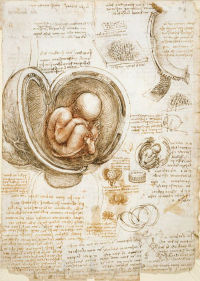The Body of Man Click on the thumbnails to explore the trail
Read more about this trail (expand)
According to Leonardo, man himself was at the centre of everything– “The measure of all things”. Throughout his life, the artist engaged in a dynamic and increasingly in-depth examination of man as a living organism, embarking on a seemingly unending quest to discover how man moved, grew, developed and perceived the world in which he lived.

- Enlarge
- Zoom & explore
- The Royal Collection © 2005, Her Majesty Queen Elizabeth II
The foetus in the womb c1510-12
Leonardo’s study of the human body led him to investigate the phenomenon of reproduction. Through the process of drawing, he attempted to understand the miraculous phenomena that govern the growth and development of the foetus in the mother’s womb.
On this sheet, he seems to be exploring the very mystery of creation itself. The fineness of the technique indicates a process of intense searching and inquiring. Great attention has been paid to recording every element in the finest detail, as Leonardo’s artistic and scientific interests combine perfectly.
Leonardo had access through dissection to a human foetus of approximately seven months, which he represented in a group of surviving drawings from various viewpoints. Here in the main drawing, the uterus and embryonic membranes are shown bursting magically open like the coverings of a germinating bud to reveal a foetus in the breech position. The umbilical cord is shown coiled in a serpentine line. The cotyledons of the placenta are observed from the uterus of a cow, and are added to the human foetus to produce as comprehensive an image as possible of the reproductive system.
In Leonardo's words
This work must commence with the conception of man, and must describe the nature of the womb, and how a baby lives in it, and in what degree it resides there, and the way it is enlivened and nourished, and its growth, and what interval there will be between one degree of growth and the next, and what it is which pushes it out of the mother and for what reason it sometimes comes out of its mother’s womb before due time.
Leonardo had access through dissection to a human foetus of approximately seven months, and represented it in a group of surviving drawings from various viewpoints.
Here, in the main drawing, the uterus and embryonic membranes are shown bursting magically open like the coverings of a germinating bud to reveal a foetus in the breech position, with the umbilical cord coiled in a serpentine line.
The cotyledons of the placenta are observed from the uterus of a cow, and are added to the human foetus to produce as comprehensive an image as possible of the reproductive system.
- Medium Pen and ink over red chalk
- Size 30.5 x 22 cm
- Location The Royal Collection










